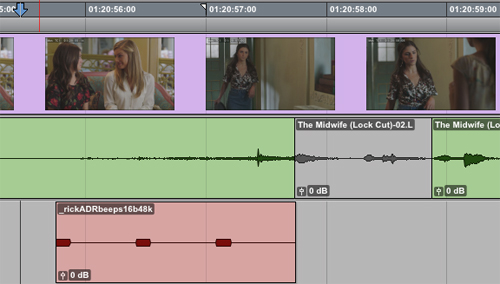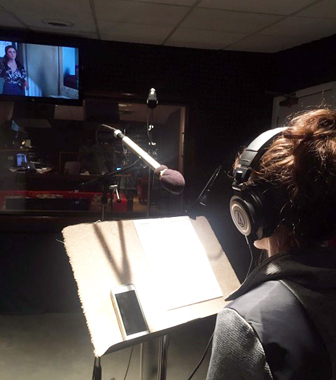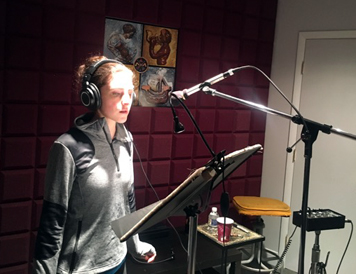Despite the best efforts of directors and sound recordists, dialog captured during a shoot sometimes proves unusable and must be replaced. The reasons for this are myriad—from environmental noise, to technical difficulties, to actors mumbling their lines—and audio problems are often not discovered until shooting has wrapped and the project is in post-production.
Replacing unusable dialog is no easy task. The actor has to be located and sent to a studio where she must get back into character and rerecord lines or individual words in sync with a performance that may have been filmed weeks or months earlier. There are challenges for the sound techs as well, who must ensure that the replacement dialog matches both the actor's on-screen mouth movements and the sound of the earlier recording. All of this is accomplished in a process known as ADR, which stands for "Automatic" or "Automated" Dialog Replacement. The nomenclature is somewhat misleading, as the process is neither automatic nor fully automated.
Baker Sound began offering ADR services in 1999. We were among the first studios in the country to adopt the ISDN technology that allows digital audio to be sent and received over traditional phone lines, which enabled us to connect with production facilities around in the world. We quickly found ourselves in the deep end of the pool when Disney called to ask if we could handle some ADR sessions for a soon-to-be-released feature titled The Kid. The film stars Bruce Willis, who was in Philly shooting The Sixth Sense and had agreed to rerecord dialog if Disney could find a suitable local studio. We met all of their technical requirements and were willing to accommodate Willis' schedule, so the sessions were booked and went off without a hitch. This led to additional work for Disney and other major studios including Sony Pictures, Paramount, Warner Brothers, and HBO. In addition to films like Signs, Hart's War, The Hunting Party, and Leatherheads, we've since handled ADR sessions for popular network TV shows including Law & Order: SVU, NCIS, and Chicago P.D. We asked Baker President and Chief Engineer Rick DiDonato to answer some questions about this underappreciated aspect of audio post-production.
Would you walk us through a typical ADR session?
RD: We're usually contacted by a production coordinator or ADR supervisor who provides video and a cue sheet indicating all of the dialog to be replaced. Prior to the session we'll prep a Pro Tools project by placing three beeps in front of each cue so that the actor knows when the line is about to start.

The picture above show the three cue beeps in red below the original dialog track in green. So the actor hears "beep, beep, beep" and then starts speaking. How does she match her performance to what's on screen?
RD: She can see the video, but she can also hear the original dialog in her headphones. It's like when singers double-track vocals; they do it a bunch of times and try to match their previous performance. ADR is also called "looping" because editors used to literally create film loops that would repeat a section of dialog over and over so that actors could read along until they got a good match. Today the computer makes this much easier.

Is it hard for the actor to get an exact match?
RD: Sometimes. Actors get better at it with experience, and there are software tools like VocALign that can tighten up any minor discrepancies between the replacement and source dialog.
You mentioned software tools; are there any special technical requirements for ADR work?
RD: There are a few. First, you need a recording room that's fairly neutral-sounding because this makes it easier to match the existing production sound. You've also got to have the right microphones. Some ADR producers request certain mics, and we do our best to accommodate them. But for most sessions I set up a Shure SM81 about 12-18 inches from the actor and a Neumann KM84 placed farther back and elevated like the boom mic that's typically used during a shoot. The audio from either one may wind up being used, depending on which sounds best for the scene.
 <
<
And what's involved in connecting to the other facility?
RD: Most facilities use Pro Tools for audio production. Then you need a hardware interface like a Telos Zephyr [for ISDN] or a plug-in like Source-Connect to send and receive digital audio. This also allows you to synchronize picture playback and communicate with the director or ADR supervisor at the other facility.
Sounds like a lot to juggle.
RD: It can be, particularly when we have additional participants patched in via standard phone lines. But once you establish a workflow things tend to run smoothly.
Are you always connected to another facility for ADR work?
RD: Usually, but not always. If the director is in town, or we're working with local filmmakers, they may supervise the session in person.
You've hosted some pretty big stars like Bruce Willis, Terrance Howard, and Stanley Tucci. Any special challenges in dealing with actors?
RD: Mainly, we want to make actors feel as comfortable as possible. They may be far from home, they may have just finished a long day of shooting, and performing isolated lines of dialog over and over in a small room can feel unnatural and tedious. I think one of the reasons actors like coming to Baker is that we maintain a very low key environment. We're on a side street, so they can get in and out without being noticed. Our facility is designed to be a relaxed and welcoming space, and we work hard to make sure that the technology never gets in the way of creativity. And our studio manager does her best to meet any special requests for food, or beverages, or whatever else may make an actor feel more at home.
How does the audio you record get mixed into the final film?
RD: If we're not mixing here, we typically upload the entire Pro Tools project to the facility handling post-production sound for the film. Of course, if we connected to them digitally [via ISDN or Source-Connect] they've already got the audio at their end and we just keep what we recorded here as a backup. Beyond that, the new audio is dropped into the dialog track by the ADR editor, processed by the ADR mixer to sound as close as possible to the original, and ultimately delivered to the mix stage where it's combined with music and sound effects.
You've also worked on films like Cloudy with a Chance of Meatballs and The Land Before Time. Is the process the same for animated films?
RD: It's different, because with animated films the voices are usually recorded first and then the animators work to the audio track. With ADR you're replacing dialog that has to match what's already on screen.
Do you do other voice recording to picture that's not specifically ADR?
RD: Sure. We often record narrations to picture, and we've also recorded commentary tracks for a number of DVD releases.
One last question. What can you tell us about the ADR session with the actor pictured above?
RD: That's Katie McClellan [best known for the 2014 NBC drama Believe]. She was in to rerecord some dialog for the new Lifetime network thriller The Midwife. We were working with Marvista Entertainment in L.A.
Thanks, Rick!
RD: My pleasure.
Baker Sound is happy to answer any questions you may have about your next audio post project. Feel free to contact us online or call 1-800-369-1280 for pricing and additional information.